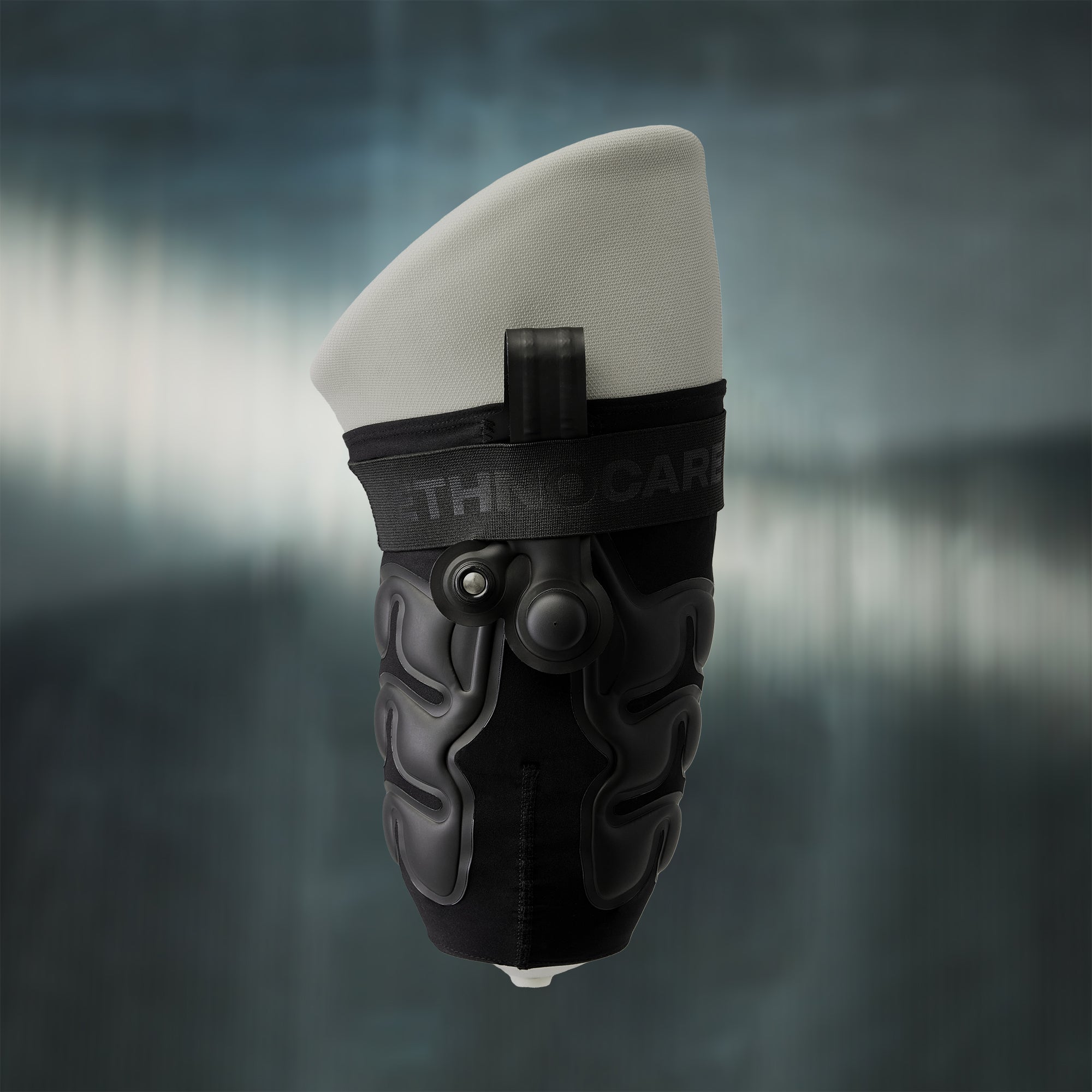

Mastering Volume Fluctuation in Transfemoral Amputees: Why the Overlay Transfemoral Is the Next-Gen Answer for Socket-Fit Comfort
Residual-limb volume fluctuation is more than an inconvenience for transfemoral amputees—it is a daily battle that can undermine socket-fit comfort, threaten skin integrity, and spike fall risk. A 2021 study in Nature Scientific Reports quantified these swings for the first time, showing that even modest shrinkage can overload distal tissues, create high shear stresses, and trigger destabilizing limb-socket pistoning. The authors concluded that any successful socket system “should be able to compensate for these fluctuations in volume.” Nature
At Ethnocare we took that challenge to heart. The Overlay Transfemoral insert was engineered specifically to deliver real-time volume management inside an existing transfemoral socket—no casting, no expensive hardware retrofits, and definitely no extra layers of sweaty prosthetic socks. In this article we break down why transfemoral volume change matters, where traditional fixes fall short, and how the Overlay Transfemoral rewrites the rule book on comfort, stability, and safety.
1 | Volume fluctuation: the hidden destabilizer
Unlike transtibial stumps, transfemoral residual limbs contain more soft tissue and fewer bony landmarks to anchor load. When daily activities—standing, sitting, cycling, or simply temperature shifts—draw fluid out of the limb, volume drops. According to the Nature study, that reduction alters stress distribution, produces “excessive distal tip loading,” and increases shear inside the socket Nature. The chain reaction looks like this:
-
Volume loss → distal end bears extra weight
-
High shear → skin breakdown, pain, dermatitis
-
Limb-socket gap → pistoning, rotation, bell-clapping
-
Prosthesis instability → higher risk of tripping or falling
In short, unmanaged volume fluctuation erodes confidence with every step.
2 | Old weapons: prosthetic socks
Historically, clinicians armed patients with two tools:
-
Prosthetic socks – quick and cheap but inherently global; adding ply everywhere just to fill a local void can create new pressure points and more heat. Socks also compress and thin out in weeks, sabotaging consistent volume management.
Neither approach satisfies the Nature mandate to “compensate for fluctuations” dynamically while the leg stays donned.
3 | Overlay Transfemoral: local, real-time volume control
Enter the Overlay Transfemoral—Ethnocare’s air-cushion insert that slips straight into a current socket shell. By mentioning the Overlay Transfemoral throughout this discussion, we want one thing clear: this device was purpose-built for transfemoral volume management. Key advantages include:
|
Overlay Transfemoral Feature |
How It Solves Volume Fluctuation |
|
Integrated circumferential air-expansion channels |
Adds support exactly where fluid loss occurs, preserving femoral alignment |
|
One-touch inflation/deflation |
User adjusts fit in seconds without doffing—crucial because the limb keeps changing in volume when it’s out of the socket |
|
Micro-adjustable pressure |
Balances distal loading, eliminates bell-clapping, and restores socket-fit comfort |
|
Retrofit friendly |
Works with laminated, thermoplastic, or even adjustable socket shells |
Because the Overlay Transfemoral lets the residual limb stay fully seated, it sidesteps the rapid post-doffing volume drift that plagues other adjustment methods.
4 | Overlay Transfemoral vs. prosthetic socks: a head-to-head look
|
Scenario |
Prosthetic Socks |
Overlay Transfemoral |
|
Mid-day shrinkage |
Remove leg, add 1–3 ply, redon |
Tap to add air while walking |
|
Hiking in heat |
Peel on/off socks repeatedly |
Micro-deflate on the trail |
|
Hygiene & skin health |
Fabric traps sweat and bacteria |
Wipe-clean, breathable liner |
|
Long-term cost |
Monthly sock replacement |
2-year documented lifespan |
|
Gait stability |
Variable; can worsen pistoning |
Maintains knee alignment, lowers fall risk |
Notice how often the Overlay Transfemoral wins on every metric that matters—real-time volume management, socket-fit comfort, and user independence.
5 | keywords that matter
Google Trends shows transfemoral users typing phrases like:
-
“transfemoral volume fluctuation fix”
-
“socket fit comfort above-knee”
-
“how to manage residual limb volume loss”
-
“alternative to prosthetic socks transfemoral”
Each of these searches points directly to the strengths of the Overlay Transfemoral. By weaving terms such as volume fluctuation, volume management, socket-fit comfort, prosthetic socks, and adjustable socket into your clinic’s content—just as we have here—you’ll capture qualified eyes and offer a concrete solution.
6 | Clinical pay-off: fewer falls, happier patients
The Nature paper warns that large residual-limb volume loss can “increase the risks of falling.” Nature When the Overlay Transfemoral prevents limb-socket gaps, knee stability improves and users trust their prosthesis on stairs, curbs, and uneven ground. Early field data from Ethnocare clinicians show:
-
Reduced skin issues – less distal reddening and fewer dermatitis reports
-
Fewer unplanned visits – socket-fit tweaks handled by the user, not the clinic
-
Greater activity levels – patients log longer walking times because they aren’t fighting fit problems all afternoon
Conclusion: Say “good-bye” to guesswork, “hello” to Overlay Transfemoral
Volume reduction will never stop—it’s part of daily physiology. But uncontrolled volume fluctuation doesn’t have to dictate comfort or confidence. By embedding responsive air technology inside the socket, the Overlay Transfemoral delivers precise, repeatable volume management that can’t be matched.

